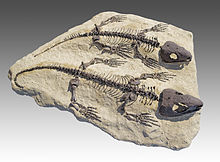
A | B | C | D | E | F | G | H | CH | I | J | K | L | M | N | O | P | Q | R | S | T | U | V | W | X | Y | Z | 0 | 1 | 2 | 3 | 4 | 5 | 6 | 7 | 8 | 9
| Captorhinids Temporal range: Pennsylvanian - Lopingian
| |
|---|---|

| |
| Fossil Captorhinus specimens | |
| Scientific classification | |
| Domain: | Eukaryota |
| Kingdom: | Animalia |
| Phylum: | Chordata |
| Class: | Reptilia |
| Clade: | Eureptilia |
| Family: | †Captorhinidae Case, 1911 |
| Type species | |
| †Captorhinus aguti | |
| Genera | |
|
See text | |
| Synonyms | |
Captorhinidae is an extinct family of tetrapods, typically considered primitive reptiles, known from the late Carboniferous to the Late Permian. They had a cosmopolitan distribution across Pangea.
Description

Captorhinids are a clade of small to very large lizard-like animals that date from the Late Carboniferous through the Permian. Their skulls were much stronger than those of their relatives, the protorothyridids, and had teeth that were better able to deal with tough plant material. The postcranial skeleton is similar to those of seymouriamorphs and diadectomorphs; these animals were grouped together with the captorhinids in the order Cotylosauria as the first reptiles in the early 20th century,[1] but are now usually regarded as stem-amniotes no closer to reptiles than to mammals. Captorhinids have broad, robust skulls that are generally triangular in shape when seen in dorsal view. The premaxillae are characteristically downturned. The largest captorhinid, the herbivorous Moradisaurus, could reach an estimated snout-vent length of 2 meters (6.5 feet).[2] Early, smaller forms possessed single rows of teeth, and were likely carnivorous or omnivorous, while the larger, more derived captorhinids belonging to the subfamily Moradisaurinae were herbivorous and developed multiple (up to 11) rows of teeth in the jaws alongside propalinal (back and forth) jaw motion, which created an effective apparatus for grinding and shredding plant matter.[3]
Histological and SEM analysis of captorhinid tail vertebrae concluded in a 2018 study that captorhinids were the first amniotes to develop caudal autotomy as a defensive function. In studied specimens a split line is present in certain caudal vertebrae that is similar to those found in modern reptiles that perform caudal autonomy. This behaviour represented significant evolutionary benefit for the animals, allowing for escape and distracting predators, as well as minimizing blood loss at an injury site.[4]
Discovery and history

Euconcordia cunninghami is thought to be the basalmost known member of Captorhinidae. A phylogenic study of primitive reptile relationships by Muller & Reisz in 2006 recovered Thuringothyris as a sister taxon of the Captorhinidae.[5] The same results were obtained in later phylogenic analyses.[6][7]
Captorhinidae contains a single subfamily, the Moradisaurinae. Moradisaurinae was named and assigned to the family Captorhinidae by A. D. Ricqlès and P. Taquet in 1982. Moradisaurinae was defined as "all captorhinids more closely related to Moradisaurus than to Captorhinus". The moradisaurines inhabited what is now China, Morocco, Niger, Russia, Texas and Oklahoma.[6]
Captorhinids were once thought to be the ancestors of turtles. The Middle Permian reptile Eunotosaurus from South Africa was seen as the "missing link" between cotylosaurs and chelonians throughout much of the early 20th century.[8] However, more recent fossil finds have shown that Eunotosaurus was either a parareptile or a diapsid, and therefore unrelated to captorhinids.[9][10]
Classification
Taxonomy
The following taxonomy follows Reisz et al., 2011 and Sumida et al., 2010 unless otherwise noted.[6][7]
- Family Captorhinidae
- Dubious Captorhinids
- Puercosaurus
- Riabininus
- Chamasaurus
Phylogeny
The cladogram below follows the topology from a 2011 analysis by paleontologists Robert R. Reisz, Jun Liu, Jin-Ling Li and Johannes Müller.[6]
Simões et al. (2022) recovered captorhinids as stem-amniotes instead, as the sister group to Protorothyris archeri, while the clade including captorhinids and P. archeri was recovered as the sister group to Araeoscelidia. A cladogram from that study is shown below.[16] Using the same data matrix, Klembara et al. (2023) found a similar result.[17]
